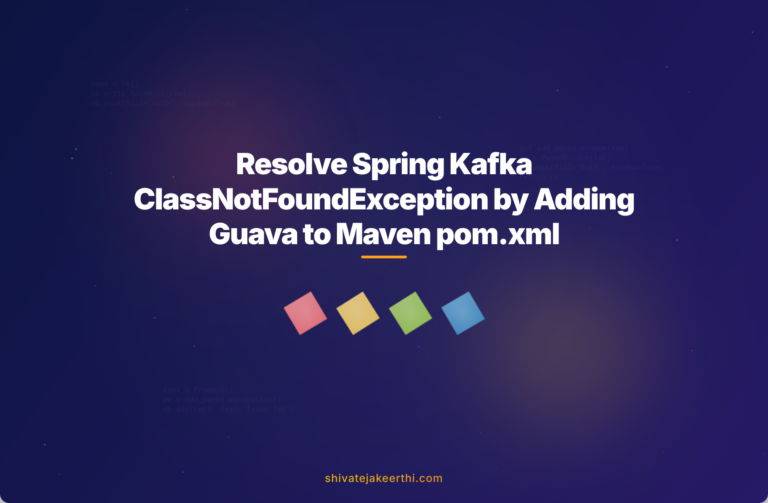When working with Spring Kafka to run batch jobs, encountering a ClassNotFoundException can be quite frustrating. Many developers recently faced a scenario where executing their Spring batch job resulted in an unexpected failure due to the absence of a seemingly unrelated class: CacheLoader. The error message looks somewhat like this:
java.lang.ClassNotFoundException: com.google.common.cache.CacheLoader
If this error strikes your console logs, don’t panic. Let’s explore what’s happening here, break it down clearly, and solve the problem together.
Analyzing the Dependency Issue: What’s Missing?
In Spring Java projects, especially those using Maven, dependencies are crucial. Your application’s functionality heavily depends on knowing exactly what libraries your code requires, specified in the pom.xml file.
The error we’re seeing specifically mentions a Google Guava class—CacheLoader—from the com.google.common.cache package. Guava is a popular Java library offering efficient caching, collections utilities, and more.
Even though your primary code might not explicitly use Guava, certain libraries like Spring Kafka internally depend on it. This indirect reference means you must explicitly declare Guava as a dependency in your project’s pom.xml file. Without it, Java cannot locate the necessary classes during runtime—thus causing the ClassNotFoundException.
Troubleshooting Your Spring Kafka ClassNotFoundException
Luckily, resolving this issue is straightforward—simply add the missing Guava dependency into your project’s pom.xml. Follow the steps below:
- Open your project’s pom.xml file.
- Insert the Guava dependency along with the exposed Maven repository version. Here’s an example for clarity:
<dependency>
<groupId>com.google.guava</groupId>
<artifactId>guava</artifactId>
<version>32.1.2-jre</version>
</dependency>
- Finally, update your Maven dependencies and rebuild your project.
Once you’ve added this dependency, the ClassNotFoundException related to CacheLoader should disappear, and your batch job will execute normally.
Examining Common Spring Kafka Batch Job Code
Let’s briefly overview some common code snippets found in Spring Kafka batch jobs to see how these dependencies interact:
Kafka Consumer Controller (Typical Spring REST Controller)
This controller usually initiates the consumer job asynchronously:
@RestController
public class KafkaJobController {
@Autowired
private KafkaJobService jobService;
@PostMapping("/launchJob")
public void launchConsumerJob() {
jobService.launchKafkaConsumerJob();
}
}
Service Class Responsible for Batch Job Execution
This service encapsulates the launching logic using Spring Batch’s JobLauncher:
@Service
public class KafkaJobService {
@Autowired
JobLauncher jobLauncher;
@Autowired
Job consumerJob;
public void launchKafkaConsumerJob() {
try {
jobLauncher.run(consumerJob, new JobParametersBuilder()
.addLong("timestamp", System.currentTimeMillis())
.toJobParameters());
} catch (Exception e) {
e.printStackTrace();
}
}
}
Spring Batch Configuration Using JobBuilderFactory
You typically build jobs and configure steps in your batch configuration:
@Configuration
public class KafkaBatchJobConfig {
@Autowired
private JobBuilderFactory jobBuilderFactory;
@Autowired
private StepBuilderFactory stepBuilderFactory;
@Bean
public Job consumerJob(Step kafkaStep) {
return jobBuilderFactory.get("consumerJob")
.start(kafkaStep)
.build();
}
@Bean
public Step kafkaStep(ItemReader kafkaReader, ItemWriter writer) {
return stepBuilderFactory.get("kafkaStep")
.chunk(10)
.reader(kafkaReader)
.writer(writer)
.build();
}
}
Custom Kafka Item Reader
A common practice is creating a custom ItemReader implementation to read Kafka messages:
public class KafkaItemReader implements ItemReader {
private KafkaConsumer<String, String> consumer;
public KafkaItemReader(Properties props, String topic) {
this.consumer = new KafkaConsumer<>(props);
consumer.subscribe(Arrays.asList(topic));
}
@Override
public String read() {
ConsumerRecords<String, String> records = consumer.poll(Duration.ofMillis(1000));
if (records.isEmpty()) {
return null;
}
for (ConsumerRecord<String, String> record : records) {
return record.value();
}
return null;
}
}
These snippets haven’t explicitly involved Guava, yet somehow you bumped into that “CacheLoader class missing” problem. This scenario happens because the frameworks or libraries used internally by Spring Kafka or other utility libraries may rely on Guava explicitly or transitively.
The Importance of Your POM File and Managing Dependencies
When working deeper into Java libraries, the pom.xml file remains your best friend. Always double-check to see if your project dependencies have conflicting versions or missing peers.
Apart from directly declared dependencies, libraries frequently have transitive dependencies. These indirect relationships make it essential to explicitly declare such dependencies, like Guava, when running into issues like ClassNotFoundException.
Understanding the Error Stack Trace Clearly
A ClassNotFoundException stack trace clearly indicates Java’s failure to locate a specific class at runtime. Consider the error you’ve encountered carefully:
java.lang.ClassNotFoundException: com.google.common.cache.CacheLoader
Here, by clearly stating com.google.common.cache.CacheLoader, Java directly identifies the missing Guava class, pinpointing the root cause: missing libraries in your project’s classpath.
Best Practices for Troubleshooting ClassNotFoundException in Java
To prevent similar problems, consider these quick best practices:
- Regularly review your dependencies: Use tools like Maven Dependency Plugin to analyze and clean your project’s dependency tree.
- Check runtime errors early: Perform thorough tests in staging environments.
- Beware of transitive dependencies: Periodically examine your dependency tree for hidden or transitive dependencies.
- Version Matching: Pay attention to version compatibility especially when upgrading libraries like Spring Kafka or Guava.
By adhering to these basic methods, you reduce future headaches caused by broken or missing dependencies.
Resolving Spring Kafka ClassNotFoundException: The Guava Solution
Facing a ClassNotFoundException with Spring Kafka due to Guava is common and fixable. In summary, follow these simple steps:
- Add Guava explicitly to your project’s pom.xml
- Rebuild the application, refresh Maven dependencies
- Confirm the issue is resolved by running your Kafka batch job again
Managing dependencies proactively helps avoid frequent runtime errors, saves valuable debugging time, and enhances application stability. So next time you see a similar issue, you’ll know exactly how to tackle it effectively.
Has this helped you solve your issue? If you’re interested in more Java Spring tips or want to share your experience, feel free to leave a comment below! Happy coding!



0 Comments